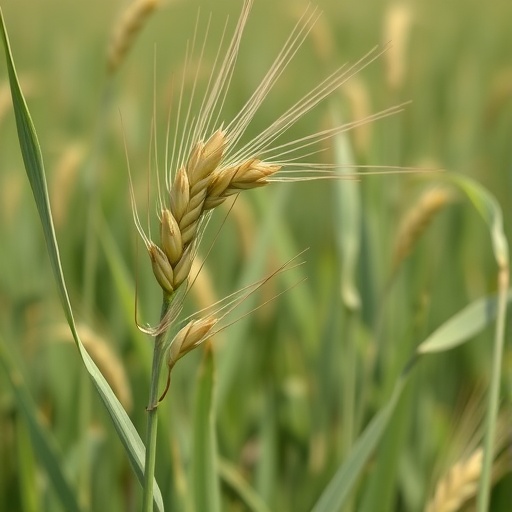In the intricate arena of modern agriculture, optimizing crop yields while ensuring quality and nutrient retention is vital not only for farmer profitability but also for food security. As global populations continue to grow, the demand for effective agricultural practices becomes increasingly urgent. One crop that stands at the forefront of this challenge is bread wheat. Recent research conducted in the North Central Highlands of Ethiopia unveils groundbreaking findings on how nitrogen (N) and phosphorus (P) can be strategically applied to enhance yield and quality in bread wheat cultivated on vertisol soils. This study, undertaken by an accomplished team of researchers, sheds light on the delicate balance between nutrient application and plant response.
Ethiopia, with its diverse topography and climatic conditions, is home to a variety of soil types, among which vertisol soils are noted for their high clay content and unique moisture retention capabilities. These properties make vertisols both a boon and a challenge for farmers. While the soil can provide adequate water supply to crops during dry spells, its heavy compactness leads to challenges during planting and harvesting. The recent study emphasizes understanding how nitrogen and phosphorus, two essential macronutrients, interact with this type of soil to optimize the performance of bread wheat.
One of the essential takeaways from the study is the recognition that the application rates of nitrogen and phosphorus are not just simple agronomic inputs; rather, they are critical determinants of wheat yield and nutritional quality. The researchers meticulously analyzed various combinations of these nutrients, considering factors such as varietal differences in wheat and prevailing climatic conditions during the growing season. Their findings suggest that precise nutrient management can lead to improvements in not just yield per hectare but also the overall health of the wheat produced.
Through rigorous experimentation, the research team noted that nitrogen, when implemented in harmonious proportions with phosphorus, had a pronounced positive effect on both yield and the quality of the bread wheat. For instance, the results pointed to a significant increase in grain weight and a higher concentration of protein, critical for both human health and processing of wheat products. This highlights the interdependence of nutrients; a well-rounded application can lead to complexities in nutrient dynamics that ultimately influence plant development.
On the other hand, the study scrutinized the detrimental effects of excessive nutrient application as well. Researchers observed that while initial boosts in yield could be achieved with high doses of N and P, the long-term sustainability of such practices is under scrutiny. The adverse impacts on soil health, including nutrient leaching and increased susceptibility to soil diseases, underscore the necessity for farmers to adhere to evidence-based guidelines when applying fertilizers.
Furthermore, the researchers conducted an in-depth analysis of the wheat varieties best suited for growth on Ethiopian vertisols. By examining indigenous strains alongside improved varieties, they discovered that certain cultivars exhibited superior responses to the applied nutrients. This revolutionary insight empowers farmers to make informed decisions regarding which seed varieties to cultivate, ultimately enhancing both yield and resilience against climatic stresses.
Key to the success of this research is the emphasis on sustainable practices. As climate change accelerates and resources dwindle, the agricultural sector faces unprecedented challenges. The findings reveal that employing appropriate rates of N and P not only boosts immediate crop outputs but also ensures that soil fertility is maintained for future generations of farmers. This research advocates for practices that not only increase productivity but also safeguard the land, echoing the principles of sustainable agriculture.
Moreover, this research fosters a growing conversation about tailoring fertilization strategies to local conditions. Region-specific agricultural practices are vital for maximizing crop performance while minimizing environmental impact. By understanding the unique characteristics of vertisols in the North Central Highlands, agronomists and farmers alike can create a synergistic relationship that bolsters productivity and economic viability.
The research team’s findings have significant implications for policy-making in agricultural governance. Policymakers can leverage these insights to formulate strategies that support local farmers, encourage the adoption of optimized fertilization practices, and ultimately bolster food security in Ethiopia. By investing in research and extension services that disseminate this knowledge, governments can create a sustainable framework for agricultural development.
As this pioneering study gains traction in the scientific community and beyond, its findings are poised to ripple through the agricultural sector. The potential for similar research to inspire changes in fertilization practices worldwide cannot be understated. By aligning modern agricultural techniques with traditional knowledge, we can pave the way for innovative solutions to complex challenges faced in crop production.
In conclusion, the exploration into optimizing nitrogen and phosphorus application for bread wheat on Ethiopian vertisols opens up new frontiers in agricultural science. This research not only emphasizes the critical role of nutrient management but also underscores a collective responsibility toward sustainable practices. It serves as a reminder that the choices made in the fields today will echo through the years to come, impacting future generations and the food systems that sustain them.
Through continued research and collaborative efforts among scientists, farmers, and policymakers, the agricultural community can work towards a future where productivity and sustainability are not seen as opposing forces but as inseparable allies in the quest for food security.
Subject of Research: Nitrogen and Phosphorus Optimization in Bread Wheat Cultivation
Article Title: Optimizing yield, quality, and nutrient uptake of bread wheat in response to N and P on Vertisols of North Central Highlands of Ethiopia
Article References:
Gete, Y., G. Selassie, Y. & Yitaferu, B. Optimizing yield, quality, and nutrient uptake of bread wheat in response to N and P on Vertisols of North Central Highlands of Ethiopia.
Discov Agric 3, 147 (2025). https://doi.org/10.1007/s44279-025-00251-2
Image Credits: AI Generated
DOI: 10.1007/s44279-025-00251-2
Keywords: Nitrogen, Phosphorus, Bread Wheat, Vertisols, Ethiopia, Sustainable Agriculture, Crop Yield, Nutrient Management, Environmental Impact.
Tags: agricultural research in Ethiopiabread wheat yield enhancementchallenges of vertisol soilscrop yield optimization strategiesfarmer profitability and crop qualityfood security and agricultureimproving nutrient retention in cropsmacronutrient management in wheatmodern agricultural practicesnitrogen phosphorus application in agriculturesustainable farming practices in Ethiopiavertisol soils in Ethiopia






